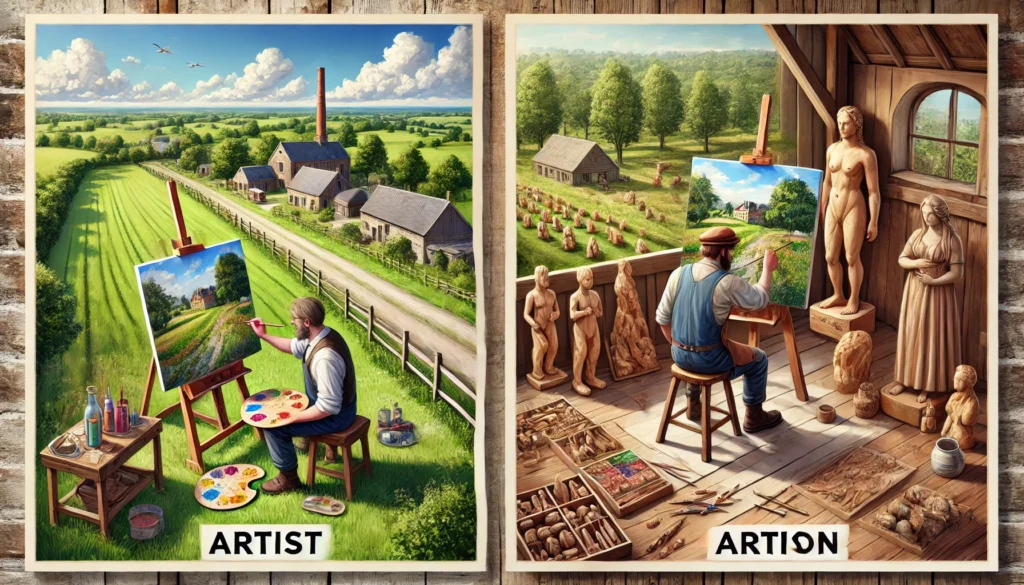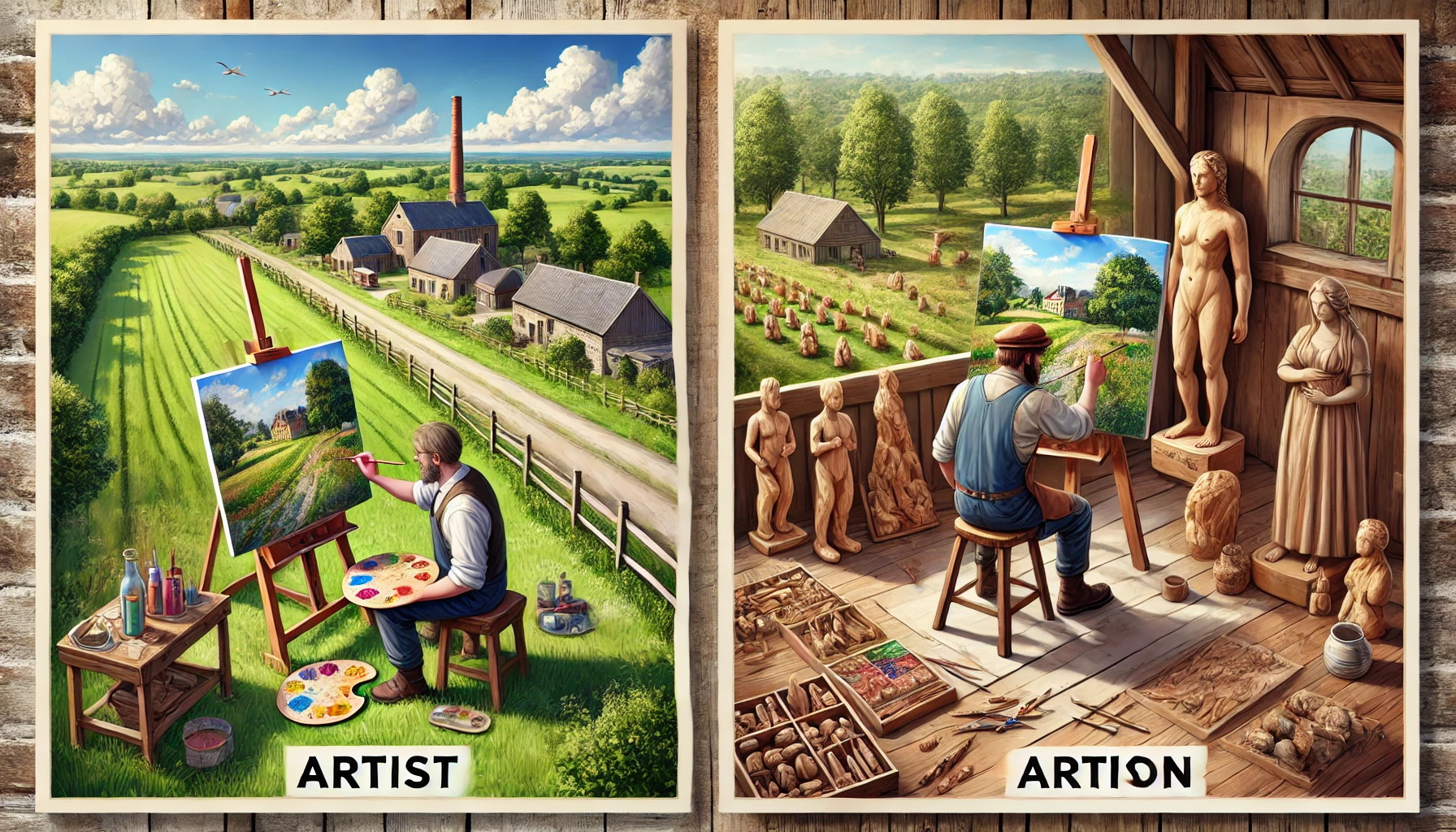
When you hear the words artist and artisan, do you picture the same person? Maybe a painter in a sunlit studio? Or a skilled woodworker shaping a beautiful chair? These terms often get mixed up—but they’re not interchangeable. While they both involve creativity and skill, the distinction between an artist and an artisan goes much deeper than surface-level assumptions.
Let’s explore the difference between an artist and an artisan, with real-world examples, historical context, modern-day relevance, and useful visuals to help you make clear sense of both terms.
Understanding the Core Definitions
What Is an Artist?
An artist is someone who creates work primarily for expression, emotion, or aesthetics. Artists aim to evoke reactions, communicate ideas, or challenge perceptions.
Read More About This Article: Add vs Ad: Clarifying Meanings and Uses
Key Traits of an Artist:
- Driven by self-expression or emotional storytelling
- Often challenges norms or explores the abstract
- Not necessarily functional—art can simply “exist”
- Mediums include painting, music, dance, digital art, sculpture
Examples of Artists:
- Vincent van Gogh – a Dutch painter known for expressive and emotional brushwork
- Banksy – a contemporary street artist whose work often carries social commentary
- Marina Abramović – a performance artist who pushes the boundaries of physical and emotional endurance
What Is an Artisan?
An artisan is a skilled craftsperson who makes goods by hand, often blending creativity with craftsmanship. Unlike the artist, the artisan focuses more on functionality, technique, and traditional methods passed down over generations.
Key Traits of an Artisan:
- Produces tangible, practical goods
- Prioritizes technique, quality, and tradition
- Repeats designs, often for commerce or everyday use
- Mediums include pottery, blacksmithing, weaving, woodworking
Examples of Artisans:
- Japanese katanakaji (swordsmiths) who forge samurai blades with precision
- Moroccan tile artisans who hand-cut intricate zellige mosaics
- Amish furniture makers known for their detailed, functional craftsmanship
Artist vs Artisan: Side-by-Side Comparison
| Aspect | Artist | Artisan |
|---|---|---|
| Primary Focus | Emotion, thought, expression | Functionality, tradition, craftsmanship |
| Mediums | Paint, sculpture, performance, music | Wood, leather, metal, textiles |
| Purpose | To inspire, challenge, or provoke | To create useful yet beautiful items |
| Innovation | High—original ideas and experiments | Often sticks to traditional styles or heritage |
| Process | Unique, conceptual, spontaneous | Repetitive, refined, technique-focused |
| Signature & Branding | Often signed, branded by the creator | Sometimes unsigned, or sold under brand/collective |
| Recognition | Exhibited in galleries, museums | Found in markets, boutiques, craft fairs |
Historical Roots of the Distinction
The split between artist and artisan wasn’t always clear. In Ancient Greece, sculptors were considered artisans. But during the Renaissance, this began to shift. Thinkers like Leonardo da Vinci and Michelangelo elevated art to intellectual and philosophical heights.
Meanwhile, artisans remained part of guilds—exclusive groups that protected secrets of trade and focused on high-quality, repeatable production. As fine art became associated with genius and emotion, craft was often sidelined as “manual labor.”
This led to a cultural divide that still lingers today.
Modern Interpretations and Blurred Lines
In today’s creative world, the difference between an artist and an artisan isn’t always black and white. Many modern creators embody both roles.
Real-Life Examples:
- Eva Zeisel – a ceramicist who created household items with artistic flair
- Rick Owens – a fashion designer known for experimental silhouettes rooted in craftsmanship
- Tattoo artists – they illustrate and ink with precision and expression
Crossover Professions:
- Culinary arts (chefs as artists with presentation, but artisans in technique)
- Furniture design (artisanship in build, artistry in form)
- Tattooing and body art
These creators fuse innovation, expression, and craftsmanship, proving that the boundary is more of a spectrum.
Cultural Views Around the Globe
Different cultures perceive artists and artisans uniquely. Here’s how the lines are drawn worldwide:
Japan:
- The concept of shokunin emphasizes not just skill but deep dedication to one’s craft. These artisans are revered for their precision and discipline.
India:
- Traditional artisans like block printers or embroidery masters are seen as preservers of heritage. Their work often crosses into art due to the rich symbolism involved.
Africa:
- Tribal mask makers create objects that are both spiritual and artistic, often for ceremonies. These pieces hold cultural significance beyond simple decoration.
How to Tell Whether Someone Is an Artist or Artisan
Still unsure if someone is an artist or artisan? Ask the following:
- Does their work have a practical use?
- Is the goal to provoke emotion or to fulfill a function?
- Do they follow traditional methods, or innovate constantly?
Quick Flowchart for Identification
+-------------------------------+
| Is the item functional? |
+-------------------------------+
|
V
+------------+------------+
| |
Yes (Useful) No (Decorative)
| |
V V
+----------------+ +---------------------+
| Made by hand? | | Created to express? |
+----------------+ +---------------------+
| |
V V
+--------------------+ +----------------+
| Likely an Artisan | | Likely an Artist|
+--------------------+ +----------------+
Common Misunderstandings
People often use the words interchangeably, but here are some mistakes worth clearing up:
- A painter can be either: a fine artist or a house painter (artisan)
- A sculptor who mass-produces souvenir figurines is an artisan, not necessarily an artist
- A digital designer working on NFTs may function as both
These illustrations show how context, intention, and application matter.
Why the Distinction Still Matters
Understanding the comparison helps in several real-world scenarios:
Branding and Marketing:
- Artists often market through galleries or online portfolios
- Artisans benefit from craft markets, Etsy, and word-of-mouth
Intellectual Property Rights:
- Artists typically protect their work via copyright
- Artisans may patent techniques or trademark product lines
Pricing Structure:
| Creator Type | Product | Price Basis |
|---|---|---|
| Artist | Original painting | Subjective/emotional |
| Artisan | Handmade chair | Time + materials |
Understanding who you’re buying from—and how the item was made—gives more respect to the creator and deeper appreciation to the craft.
Final Thoughts: Two Paths, Same Passion
An artist moves your soul. An artisan shapes your world. One may aim for emotional expression, the other for practical elegance. But both require creativity, discipline, and heart.
As writer Elbert Hubbard once said:
“Art is not a thing—it is a way.”
That way may carve stone, paint dreams, or weave heritage into a blanket. Whether you’re an artist or artisan, your hands and vision build more than objects—they build culture.
Vocabulary Glossary
| Term | Definition |
|---|---|
| Artist | Someone who creates for emotional or aesthetic purposes |
| Artisan | A skilled craftsperson who creates functional or decorative items |
| Creativity | The ability to produce original and imaginative ideas |
| Craftsmanship | High-quality skill in making things by hand |
| Expression | The process of conveying ideas, emotions, or feelings through a medium |
| Innovation | The introduction of new ideas, methods, or devices |
| Traditional | Passed down through generations; long-established |
| Sculptor | A person who creates three-dimensional works of art by carving or shaping material |
| Painter | An artist who works with paint, typically on canvas |
For more on craftsmanship and the evolving definition of art, check resources like the Crafts Council and The Art Story.
Want more content like this? Stay tuned for deep dives into words, meanings, culture, and creativity.
